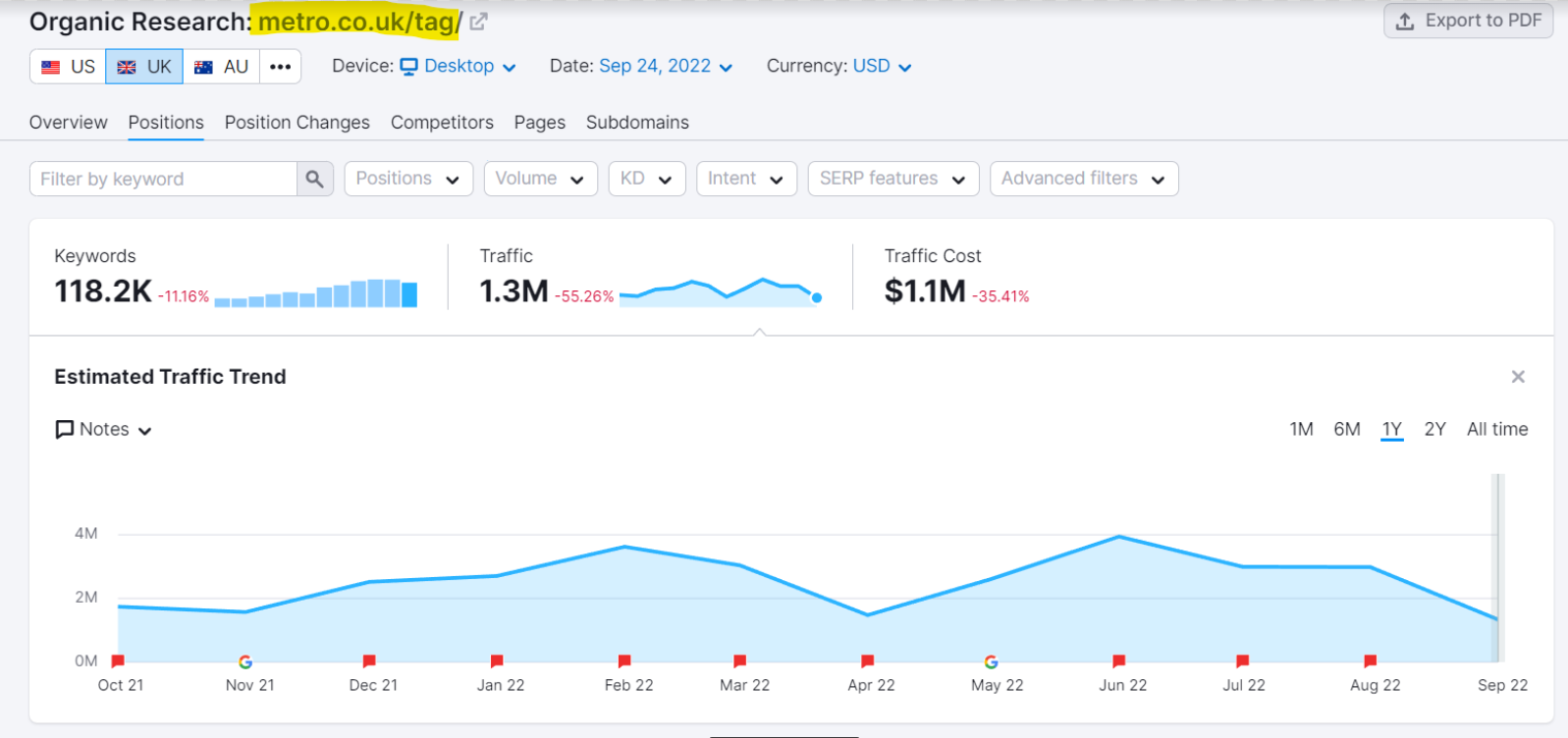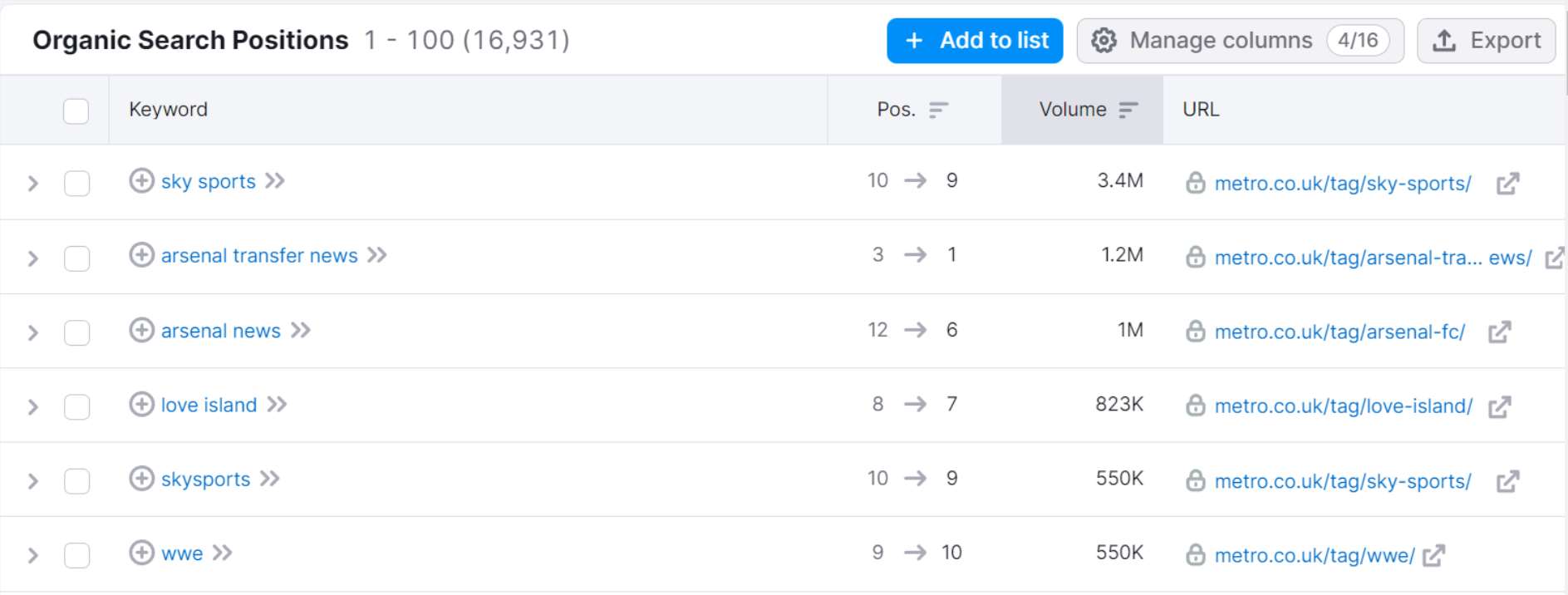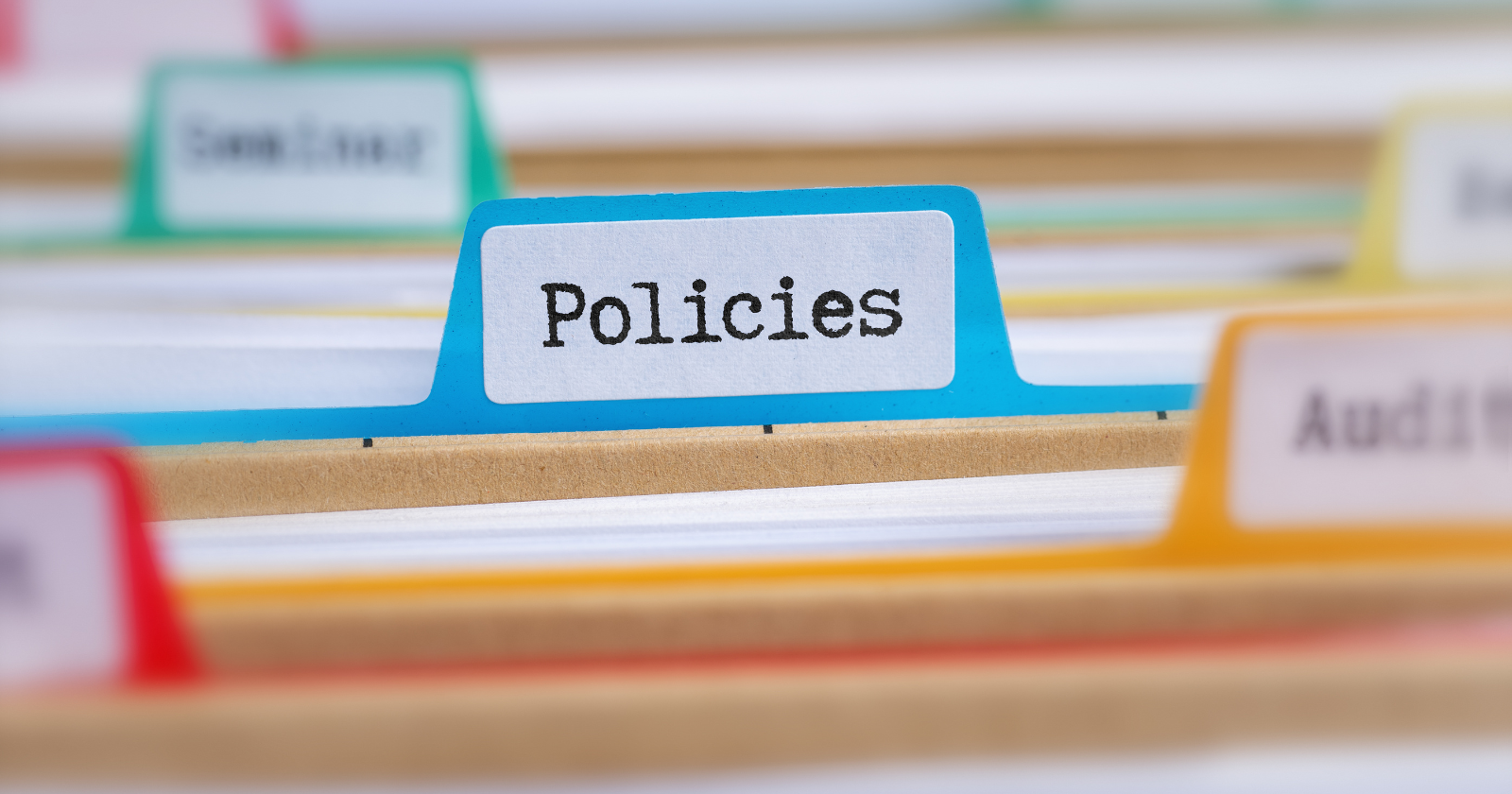September 2022 was one of the most turbulent months of recent times for news publishers.
The month started with the Helpful Content Update, which targeted low-quality, unhelpful content.
That was swiftly followed by the September 2022 Core Algorithm Update: one of Google’s broader updates, which overlapped with the September 2022 Product Reviews Update, targeting low-quality affiliate content (among other things).
For some of the biggest publishers in the game, this has caused major disruption, with publications like the Metro seeing a 40% decrease in visibility.
In an industry that often relies on fairly turbulent traffic sources such as breaking news stories and Google Discover, appropriate content tagging can provide the safety net in which traffic consistency can be somewhat more reliable.
I’ve been working with several large news publishers across entertainment, football, gaming, music, and healthcare this year, some of which attract tens of millions of users each month. They all seemed to be lacking in one particular area: content tagging.
Why Content Tagging Is Important For News Publishers
When used appropriately, content tagging can help to boost a publication’s organic performance massively. However, many publishers are getting it wrong. Three of the main motivations for optimizing content tagging are as follows.
Stronger Topical Authority
We know that with Google’s various updates, there’s a big focus on ensuring that websites that are a genuine authority for the user’s search query are ranked higher. For news publications, becoming an authority relies on a number of factors, such as author specialties, relevant backlinks, and expert content.
With content tagging, you can pull all your expert content on a particular topic into one place, making it easier for Google to crawl, find the connections between different articles, and understand just how authoritative your publication is in this area.
This means each article is directly supported by a tag page and multiple other relevant articles, giving Google more confidence in its topical authority.
Safety Net Of Consistent Organic Traffic
Tag pages can do much more than pull all of your articles together, though. They can actually become strong landing pages that rank for high-volume, generic keywords.
Due to the nature of tag pages being a central hub that can answer various questions on a specific subject, Google is more likely to rank a tag page within the normal organic listings (rather than Top Stories, etc.) for a high search volume generic query.
For example, when someone searches for “Love Island,” there isn’t a huge amount of context behind what the searcher is looking for about Love Island. By serving a tag page, Google gives the user a wider variety of content to consume, therefore increasing the likelihood of satisfying their search intent.
Using the Metro as an example, a quick look in Semrush shows tag pages potentially pulling in hundreds of thousands (and in many cases millions) of organic users each month.

Screenshot from Semrush, September 2022
And most of this tag page traffic, unsurprisingly, is coming from the high volume, generic keywords such as”‘Love Island”:

Screenshot from Semrush, September 2022
When the Metro also ranks in Top Stories for “Love Island,” they’re doubling the chances of capturing the click.
If they do happen to see a drop in organic performance for their Love Island articles, their site still has the safety net of the tag page to pull in the traffic from high-volume, generic keywords.
That is, if the tag page maintains rankings, of course.
What Can Happen Without A Tagging Policy
Having started working with a few large publications which haven’t properly implemented a tagging policy, I’ve seen firsthand how messy things can get when a tagging policy isn’t in place.
When not properly trained on the ins and outs of content tagging and how it relates to SEO, writers have added endless random tags to articles, creating masses of tag pages that offer no real benefit to the website.
From an SEO perspective, these are the issues this causes:
- Wasted crawl budget: When large volumes of articles are created daily, alongside masses of new tag pages, this results in Googlebot (and other bots) wasting resources by crawling low-quality tag pages rather than the articles themselves.
- Diluted topical authority signals: When tagging is overdone, you can end up with multiple tag pages which essentially focus on the same subject but spread the articles and topical authority across multiple tags. An example of this would be writing an article about Cristiano Ronaldo breaking his nose, then creating a tag page for “Cristiano Ronaldo,” “Cristiano Ronaldo nose,” “Cristiano Ronaldo broken nose,” and “Cristiano Ronaldo nose injury.” Really, we only need the “Cristiano Ronaldo” tag here, as the article itself will be targeting the “nose” related keywords. So, not only does the main “Cristiano Ronaldo” tag page have to compete with three other related tag pages, the article itself does, too.
- Index bloat: When niche tag pages are created (such as “Cristiano Ronaldo nose” and “Cristiano Ronaldo nose injury”), they end up having just one article tagged, resulting in thin, low-quality tag pages being indexed, which end up being almost exact duplicates of each other.
- Hardly any traffic or rankings for tag pages: When writers don’t know how to effectively tag content and optimize tag page performance, the tag pages just end up being a wasted opportunity, as they likely won’t rank or drive traffic.
When improper tagging has been done for a long time, the clean-up job is quite time-consuming and requires detailed analysis to ensure nothing of value is removed. Prevention is definitely better than the cure!
So, tag pages can act as the glue that holds relevant content together and as consistent, evergreen traffic drivers when article performance declines.
But how do you ensure your writers are united in an approach to tagging which benefits the site as a whole? Through tagging policies, of course!
How To Implement Tagging Policies For Writers
Every news publication that publishes content on multiple topics should have an appropriate tagging policy in place, but what should be included? And how should it be written? Below are the items I would advise publishers to focus on.
Create An Introduction To The Policy
Start with a one-paragraph explanation of why the policy is needed and what it aims to achieve. If tagging has been a historical issue for the site, then this is an opportunity to give examples of where things have gone wrong and why. This helps writers to understand the purpose of the policy.
Rule 1: Make Tags Generic Yet Relevant
As mentioned earlier, tags have real potential to rank for high search volume generic keywords, so they should ideally target just that!
You also prevent the risk of diluting topical authority signals through multiple niche tag pages, which all compete for similar keywords.
Rule 2: Use A Maximum Of X Tags Per Article
A good target for tagging is to have one or two tags per article (though this does vary for each publication).
That way, writers will be less likely to create multiple, similar tags, which helps to control index bloat and crawl budget efficiency.
Rule 3: Use Existing Tags Where Possible
Hopefully, your publication creates more than one story per topic, so ensure writers are searching for an appropriate existing tag before they start creating a new one.
Rule 4: Use Lowercase Text And No Special Characters
Depending on the system being used, tags that writers input with capital letters or special characters can end up being applied to the tag page’s URL, which isn’t ideal – and can, once again, result in duplicate tag pages being created (e.g.,/Cristiano-Ronaldo/ and /cristiano-ronaldo/) or just generally unoptimized and messy URLs.
Rule 5: Add Internal Links To Tag Pages From Articles
This one is important. While all of the other points relate to the creation of tagging pages, internal linking from articles is how you start to build up the authority of the tag page itself.
Writers should be linking to the article’s main tag page within the first paragraph if possible, and to other secondary tag pages within the rest of the article where possible.
Ensure You Are Providing Context
One of the main reasons writers end up not adhering to general rules around content tagging is that they simply haven’t been given the context behind why they should be doing things a certain way.
A publication’s SEO strategy relies on writers understanding how their efforts support that strategy, so ensure training is done to help them understand why tagging needs to be done a certain way (feel free to point them towards this article!).
The policies themselves should be simple documents that just outline the basic rules of tagging, almost like a checklist. Training should be provided with the introduction of these policies to provide the context, which can be done in video form to ensure everyone gets the exact same training.
General Tag Page Setup
Beyond the writer’s responsibilities, publication owners need to ensure they have the right technical setup to support the growth of tag pages, too. The following areas should be adequately addressed to support the writer’s efforts.
Convert Tag Pages To Landing Pages
Simple things like indexability need to be considered when setting up tag pages, as well as basic optimizations such as meta titles and descriptions, headers, and intro text.
Providing more detail than your competitors’ tag pages (bio information, introductory text with internal links to related tag pages, etc.) and ensuring that many tagged articles are made immediately available on the first page will also give you an advantage.
Break Content Up Over Multiple Pages
Pagination is an important consideration, and although Googlebot can crawl and index pages that utilize infinite scrolling, my preference would be to break content up over multiple pages, using pagination to make things simpler for Googlebot and avoid any potential issues with rendering, etc.
Add Tag Page Breadcrumbs To Articles
Although writers and editors are responsible for ensuring internal links to tag pages are included within the article’s body text, the technical setup of the page should ensure that the main tag page is linked to by default.
Add breadcrumbs to the top of each article that links to the main tag for that particular article. Article pages will often include a breadcrumb link to the main category (e.g., “Music”), but breadcrumbs also present a fantastic opportunity to promote tag pages.
Add Tag Page Breadcrumbs To Article Schema
Along with the physical breadcrumb link on the page itself, breadcrumb schema can be used within the Article or NewsArticle schema on the page to link to the tag page, giving Google another indication of the connection between the two pages.
Create A Tag Page XML Sitemap
Big news publications inevitably end up with multiple XML sitemaps, including a Google News sitemap and multiple other sitemaps for the masses of older articles, all stored within a sitemap index.
There is also a great opportunity to group tag pages together within their own sitemaps, which can be split out according to their category.
For example, “Artist” sitemaps for music publications, “Team” sitemaps for sports publications, etc., give Googlebot quick and easy access to these important pages.
Create HTML Sitemaps For Priority Tags
To make tag pages even more accessible to both crawlers and users, creating HTML sitemaps is a great way to ensure there are easily accessible internal links to all of your priority tag pages, which essentially become topic indexes.
Again, this might come in the form of an ‘Artists’ or ‘Teams’ page.
Conclusion
Publication owners need to lead by example when it comes to tagging, so by creating a technical setup that prioritizes tag page visibility and sharing a tagging policy that helps writers to understand what they should be doing – and why they should be doing it – everyone can work towards the same goal together.
More resources:
- Tag Pages & Content Tagging For SEO: A Complete Guide
- Tagging Blog Posts: Do Blog Tags Help SEO?
- How to Optimize Categories & Tag Pages for More Search Traffic
Featured Image: Zerbor/Shutterstock





